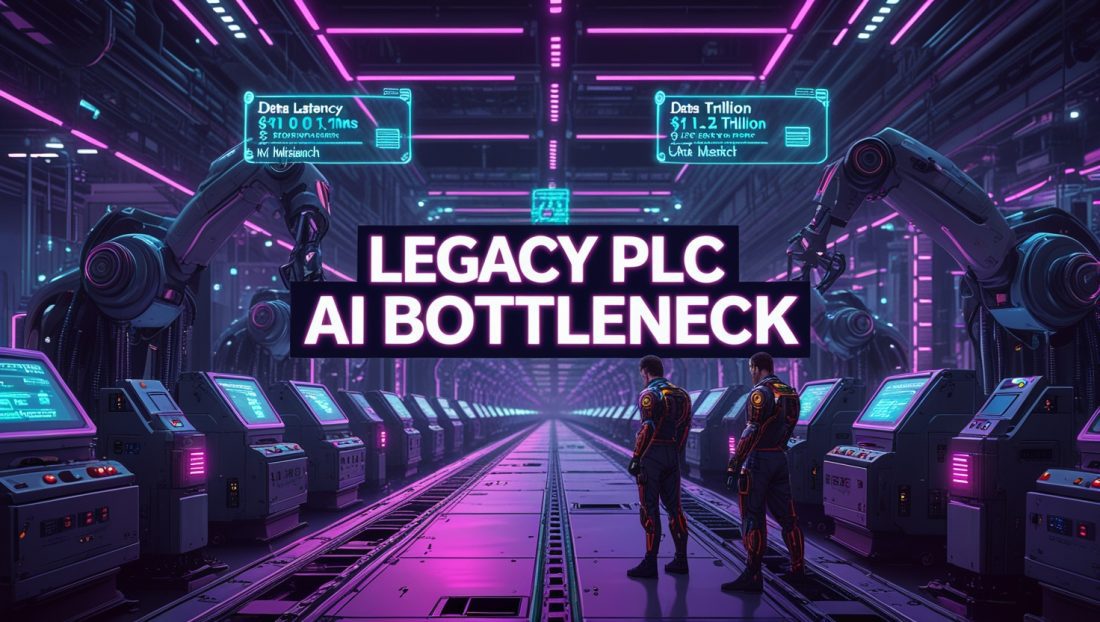The Fiction: At a German automotive plant, engineers celebrated their new AI predictive maintenance system. Yet production line failures increased by 17% within months. The culprit? A Legacy PLC AI bottleneck—thirty-year-old PLCs feeding inconsistent torque data to their AI models, creating false alarms that halted assembly lines hourly.
The $1.2 Trillion Legacy PLC AI Bottleneck
Industrial AI’s promise collides with a brutal reality: 68% of manufacturing plants still operate Programmable Logic Controllers (PLCs) older than 15 years. These unassuming metal boxes have become silent saboteurs in hybrid infrastructure, throttling AI systems through three primary mechanisms:
1. Data Friction: The 300ms AI Killer
Legacy PLCs create serialization deserts where real-time data starves. Consider these impacts:
- Protocol translation lag: Modbus-to-OPC gateways add 150-400ms latency per data point
- Sampling mismatch: 10Hz PLCs vs. 1000Hz AI sensors create temporal misalignment
- Data integrity gaps: 32% of plants report dropped sensor packets from aging controllers
Anja Müller, Siemens industrial AI lead, noted in a 2025 Manufacturing Tech Insights report that AI vision systems often detect defects that PLCs cannot process due to slow I/O refresh rates. For deeper insights into how industrial AI analytics can overcome such bottlenecks, explore Industrial AI Analysis Boost Efficiency Survive in 2025, which details strategies to enhance factory performance.
Solution Pathway:
- Deploy edge-based protocol normalizers before AI ingestion points
- Implement time-synchronized data historians with nanosecond precision
- Adopt IEEE 1588 precision timing across operational technology (OT) networks
2. Security Blind Spots: The Pickai Backdoor Parallel
The 2025 Pickai malware attack that exploited ComfyUI vulnerabilities mirrors risks in legacy PLC environments. Outdated controllers create invisible threat vectors:
| Risk Factor | % of Plants Affected | AI Impact |
|---|---|---|
| Unpatched Firmware | 61% | Model poisoning via false data |
| Clear-text Data Logs | 44% | Training data exfiltration |
| Hardcoded Credentials | 39% | Unauthorized model adjustment |
Unlike modern systems with encrypted data pipelines, 87% of Allen-Bradley SLC 500 series PLCs transmit process data unencrypted—creating perfect attack surfaces for industrial AI sabotage. To understand how AI-driven cybersecurity can mitigate such risks, check out AI-Driven Cybersecurity Threat Detection Master, which explores advanced threat detection strategies. Additionally, Rockwell Automation’s guide on securing industrial control systems offers practical steps to harden legacy systems against cyber threats.
3. The Integration Tax: When 30% of AI Budgets VanishRetro
fitting legacy PLCs consumes disproportionate resources:
- Engineering hours: 150-400 hours per production line for signal mapping
- Middleware costs: $12,000-$45,000 per controller for protocol conversion
- Model accuracy tax: Up to 40% reduction in predictive maintenance precision
A McKinsey industrial automation survey (Q2 2025) reveals that plants using PLCs older than 2010 spend 2.7x more on AI data preparation than those with modern controllers. For a deeper dive into optimizing predictive maintenance ROI, How AI Boosts Predictive Maintenance ROI in 2025 provides actionable strategies to maximize efficiency.
The Modernization Roadmap
Phase 1: Strategic Controller Triage
- Classify by criticality: Tag PLCs by downtime cost ($/minute) and AI dependency
- Deploy OT proxying: Install unidirectional gateways for safe data extraction
- Adopt cyber-physical twins: Mirror legacy systems in secure virtual environments
Phase 2: Progressive Decoupling
- Edge normalization: Raspberry Pi-sized protocol converters at $230/node
- Data quality scoring: IBM’s OT Data Trust Index for AI readiness
- Phased controller replacement: Prioritize high-velocity production lines
To explore how digital twins can further enhance modernization efforts, IBM’s digital twin technology overview provides a comprehensive look at virtual system integration.
Real-World Fixes: Where ROI Speaks
Case Study: TexEnergy Petrochemical saved $4.7M/year by:
- Adding time-sync buffers to 1980s-era Modicon PLCs ($12k investment)
- Installing AI pre-processors that clean vibration data before cloud ingestion
- Achieving 92% model accuracy vs. previous 61% with raw PLC feeds
FAQ: The PLC-AI Dilemma Solved
Can we use AI without replacing all our PLCs?
Absolutely. Middleware solutions like Ignition Edge or Siemens MindSphere Edge can bridge 80% of data gaps at 20% of the replacement cost.
How do we measure PLC-induced AI performance loss?
Track “AI Decision Latency” (time from sensor input to AI output) and “Data Coherence Index” (synchronization accuracy across sources).
Are legacy PLCs violating new cybersecurity regulations?
Yes. NIST SP 800-82 Rev 3 (2024) mandates encrypted OT communications—non-compliant plants face 4-7% revenue penalties.
Dr. Elena Petrova, Industrial AI Research Lead at MIT, emphasizes, “The factories of the future will run on AI, but only if we heal the circulatory system of industrial data first. That starts with modernizing our control layer.”
Your Take
Legacy PLCs sabotage AI through data latency, security gaps, and integration costs. Solutions include: 1) Edge-based data normalization 2) Cyber-physical isolation 3) Phased controller replacement. Plants ignoring this risk 20-40% lower AI ROI.
Ready to audit your PLC-AI readiness?
Download Our Free Plant Infrastructure Scorecard → (Coming Soon)
Includes vulnerability assessment template & modernization ROI calculator don’t forget to subscribe to our Newsletter.
